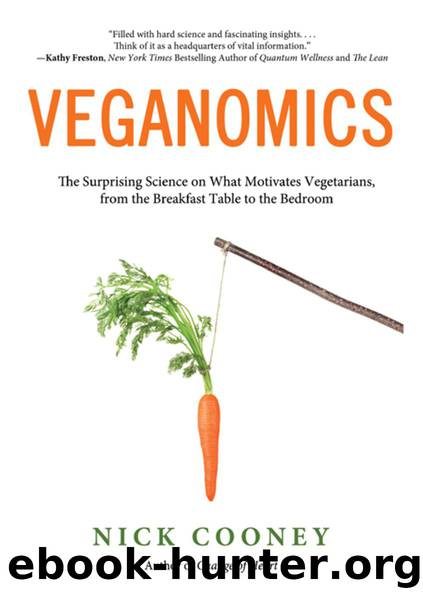Veganomics: The Surprising Science on What Motivates Vegetarians, from the Breakfast Table to the Bedroom by Cooney Nick

Author:Cooney, Nick [Cooney, Nick]
Language: eng
Format: epub
ISBN: 9781590564295
Publisher: Lantern Books
Published: 2013-08-29T03:00:00+00:00
Nature vs. Nurture
Just as the family we grow up in affects who we become, the political, financial, and geographic circumstances of a country affect how much meat it consumes.
Among countries whose citizens have a high average income, there is little country-to-country difference in how much meat each citizen eats. Say you put into a hat the names of the twenty-five countries with the highest average income levels. You then put your hand in the hat, fished around, and pulled out two: Denmark and France. Let's say you happened to know that the average French person makes about $4,500 more per year than the average Dane. Unfortunately, that information would be of no help to you in predicting which nation eats more meat.
One piece of data, however, does allow you to determine more accurately which high-income country consumes more meat. The piece of data? How equally wealth is distributed in each country. High-income countries with more equal distribution of wealth tend to eat less chicken and beef, with no increased consumption of other meat products (Morris).
Why would this be the case? The researchers who discovered this intriguing finding speculate that countries with a more egalitarian society are also more compassionate toward animals. Countries that haven't yet extended that spirit of concern throughout human society have also failed to extend it to farm animals. There's other evidence that countries with a more equal distribution of wealth care more about farm animals: they tend to regulate factory farming more strictly (Morris).
As we take a broader look around the world, and leaving aside wealth distribution among individual citizens, we can see one factor that really predicts how much meat any particular country eats: Gross Domestic Product (GDP). (GDP is the value of all goods and services produced by a country each year.) Per capita GDP is strongly related to meat consumption. Along with population growth, growth of GDP has led to dramatically higher rates of meat consumption around the globe.
In Asia, each $1,000 increase in per capita GDP corresponds to a 3-pound rise in meat consumption. In Africa, the same GDP growth leads to a 4-pound growth. In the global North it corresponds to an average 6-pound increase, and in the Middle East higher GDP leads to a whopping 9-pound rise.
While East Asians don't increase their red- and white-meat consumption as much as other regions as their GDP increases, their fish consumption goes up much more. A $1,000 increase in per capita GDP leads Asian nations to consume 5 pounds more fish per capita, compared to about 2 pounds in Western, African, and Middle Eastern nations.
A few other national and geographic factors influence how much meat people eat. For one thing, countries with more of their population living in urban areas eat more red and white meat. This phenomenon might be attributable to the fact that such populations have access to a wider variety of food, or are more likely to have access to refrigeration. Or it could simply be that urbanization goes hand-in-hand with an increase in GDP, and we know that as GDP increases so meat consumption rises.
Download
This site does not store any files on its server. We only index and link to content provided by other sites. Please contact the content providers to delete copyright contents if any and email us, we'll remove relevant links or contents immediately.
| Biomathematics | Differential Equations |
| Game Theory | Graph Theory |
| Linear Programming | Probability & Statistics |
| Statistics | Stochastic Modeling |
| Vector Analysis |
Weapons of Math Destruction by Cathy O'Neil(5049)
Factfulness: Ten Reasons We're Wrong About the World – and Why Things Are Better Than You Think by Hans Rosling(4032)
Factfulness_Ten Reasons We're Wrong About the World_and Why Things Are Better Than You Think by Hans Rosling(2759)
Descartes' Error by Antonio Damasio(2745)
A Mind For Numbers: How to Excel at Math and Science (Even If You Flunked Algebra) by Barbara Oakley(2694)
TCP IP by Todd Lammle(2646)
Applied Predictive Modeling by Max Kuhn & Kjell Johnson(2489)
Fooled by Randomness: The Hidden Role of Chance in Life and in the Markets by Nassim Nicholas Taleb(2420)
The Book of Numbers by Peter Bentley(2412)
The Tyranny of Metrics by Jerry Z. Muller(2407)
The Great Unknown by Marcus du Sautoy(2192)
Once Upon an Algorithm by Martin Erwig(2152)
Easy Algebra Step-by-Step by Sandra Luna McCune(2123)
Practical Guide To Principal Component Methods in R (Multivariate Analysis Book 2) by Alboukadel Kassambara(2099)
Lady Luck by Kristen Ashley(2079)
Police Exams Prep 2018-2019 by Kaplan Test Prep(2039)
Linear Time-Invariant Systems, Behaviors and Modules by Ulrich Oberst & Martin Scheicher & Ingrid Scheicher(1986)
All Things Reconsidered by Bill Thompson III(1964)
Secrets of Creation, Volume 1: The Mystery of the Prime Numbers by Watkins Matthew(1874)
